Books for Review
To request a book for review, please email journaloflithicstudies@gmail.com.
 |
Lithic Technological Systems and Evolutionary TheoryEdited By Nathan Goodale, William Andrefsky, Jr.2015 | Cambridge University Press (external site) Copy Available: No Language: English Pages: 318 ISBN: 9781107026469 Stone tool analysis relies on a strong background in analytical and methodological techniques. However, lithic technological analysis has not been well integrated with a theoretically-informed approach to understanding how humans procured, made, and used stone tools. Evolutionary theory has great potential to fill this gap. This collection of essays brings together several different evolutionary perspectives to demonstrate how lithic technological systems are a byproduct of human behavior. The essays cover a range of topics, including human behavioral ecology, cultural transmission, phylogenetic analysis, risk management, macroevolution, dual inheritance theory, cladistics, central place foraging, costly signaling, selection, drift, and various applications of evolutionary ecology. |
 |
Over The Hills and Far Away: Last Glacial Maximum Lithic Technology Around the Great Adriatic PlainBy Emanuele Cancellieri2015 | Archaeopress (external site) Copy Available: No Language: English Pages: 125 ISBN: 9781784912345 The research scope of this book is the human occupation of the northern Adriatic region at the end of the Last Glacial Maximum (ca. 24,000- 20,000 calBP), and a point of view over the long debated occupation of the once exposed Great Adriatic Plain and the role it played within the early Epigravettian hunter-gatherers settlement system. The study relied on a comprehensive techno-economic approach to lithic technology, one among the possible means to investigate site function, mobility and land use. |
 |
Flint Daggers in Prehistoric EuropeEdited By Catherine Frieman, Berit Valentin Eriksen2015 | Oxbow Books (external site) Copy Available: No Language: English Pages: 176 ISBN: 9781785700187 For more than a century flint daggers have been among the most closely studied and most heavily published later prehistoric lithic tools. It is well established that they are found across Europe and beyond, and that many were widely circulated over many generations. Yet, few researchers have attempted to discuss the entirety of the flint dagger phenomenon. The present volume brings together papers that address questions of the regional variability and socio-technical complexity of flint daggers and their production. It focuses on the typology, chronology, technology, functionality and meaning of flint and other lithic daggers produced primarily in Europe, but also in the Eastern Mediterranean and East Asia, in prehistory. The 14 papers by leading researchers provide a comprehensive overview of the state of knowledge concerning various flint dagger corpora as well as potential avenues for the development of a research agenda across national, regional and disciplinary boundaries. The volume originates from a session held at the 2011 meeting of the European Association of Archaeology but includes additional commissioned contributions. |
 |
Wild Things: Recent Advances in Palaeolithic and Mesolithic ResearchEdited By Frederick W. F. Foulds, Helen C. Drinkall, Angela R. Perri, David T.G. Clinnick, James W.P. Walker2014 | Oxbow Books (external site) Copy Available: No Language: English Pages: 208 ISBN: 9781782977469 Recently, Palaeolithic and Mesolithic archaeology has been breaking boundaries worldwide. Finds such as the Mesolithic house at Howick, the sequencing of the Neanderthal genome, and the recently discovered footprints at Happisburgh all serve to indicate how archaeologists in these fields are truly at the cutting edge of understanding humanity’s past. This volume celebrates this trend by focusing on recent advances in the study of the Palaeolithic and Mesolithic. With contributors from a diverse range of backgrounds, it allows for a greater degree of interdisciplinary discourse than is often the case, as the Palaeolithic and Mesolithic are generally split apart. Wild Things brings together contributions from major researchers and early career specialists, detailing research taking place across the British Isles, France, Portugal, Russia, the Levant and Europe as a whole, providing a cross-section of the exciting range of research being conducted. By combining papers from both these periods, it is hoped that dialogue between practitioners of Palaeolithic and Mesolithic archaeology can be further encouraged. Topics include: the chronology of the Mid-Upper Palaeolithic of European Russia; territorial use of Alpine high altitude areas by Mesolithic hunter-gatherer; discussing the feasibility of reconstructing Neanderthal demography to examine their extinction; the funerary contexts from the Mesolithic burials at Muge; the discovery of further British Upper Palaeolithic parietal art at Cathole Cave; exploitation of both lithics and fauna in Palaeolithic France; and an analysis of Mesolithic/Neolithic trade in Europe. |
 |
No Stone Unturned: Papers in Honour of Roger JacobiEdited By Nick Ashton, Claire Harris2015 | Lithic Studies Society Copy Available: No Language: English Pages: 280 ISBN: 0-9513246-4-0 This volume of papers is in honour of Roger Jacobi one of the great prehistorians of his generation. The papers have been written by his former students, colleagues and friends, reflecting the full breadth of his research. |
 |
Peuplement de l'Amérique du sud: L'apport de la technologie lithiqueEdited By Maria Farias, Antoine Lourdeau2014 | @rchéo-éditions (external site) Copy Available: No Language: Portuguese Pages: 398 ISBN: 978-2-36461-005-7 Peuplement de l'Amérique du sud: l'apport de la technologie lithique Povoamento na América do Sul: a contribuição da tecnologia lítica Población de América del sur: la contribución de la tecnología lítica |
 |
Techno-logique & Technologie: A Paleo-lithic history of sharp objectsBy Eric Boëda2013 | @rchéo-éditions (external site) Copy Available: No Language: French Pages: 266 ISBN: 978-2-36461-003-3 Techno-logique & technologie, en deux mots tout est dit. Deux mots cependant qu’il convient d’éclaircir à partir de la matière même à laquelle ils sont appliqués ici et qui, en retour, en constitue le fondement épistémologique, à savoir: les industries lithiques de la préhistoire. |
 |
Le Concept Levallois: Variabilité des méthodesBy Eric Boëda2013 | @rchéo-éditions (external site) Copy Available: No Language: French Pages: 290 ISBN: 978-2-36461-008-8 Un peu comme une «contre-méthode» libérée des rets de la typologie, cette recherche sur le Levallois s’impose comme une nouveauté sur un plan théorique. Ce travail résolument moderne, d’exception française, nous invite à revoir les habitudes de lecture du matériel archéologique. Tout en redécouvrant le Levallois par la voie conceptuelle autant qu’expérimentale, l’auteur a façonné une pensée de l’abstraction et de la théorie, qui a ouvert une nouvelle voie analytique dans l’étude des assemblages de pierre du Paléolithique moyen, plus vivante, incarnée, structurée, signifiée entre percept et concept: une autre vision du monde technique au Paléolithique. Si, aujourd’hui, le débitage Levallois a plus d’un siècle depuis sa découverte par Victor Commont dans les carrières de Levallois-Perret dans les Hauts-de-Seine, son explication n’a, à peine, qu’une trentaine d’années. Il semble que le Levallois n’ait jamais été le même depuis sa découverte, d’une définition à l’autre, sa compréhension semble glisser entre les mains du préhistorien comme fuyant toute théorisation jusque dans les années 1980. Et ce, même si l’on doit reconnaître les travaux pionniers de F. Bordes, de M. Dauvois et de A. Leroi-Gourhan, précurseurs qui ébauchèrent les notions fondamentales de prédétermination, de concept et de variante dans le débitage, de chaîne opératoire, de tendance et de fait ou de nuance. Qu’ont-ils tenté sinon d’essayer de comprendre ce qu’ils n’étaient pas parvenus à expliquer? Qu’entend-on par comprendre le Levallois? |
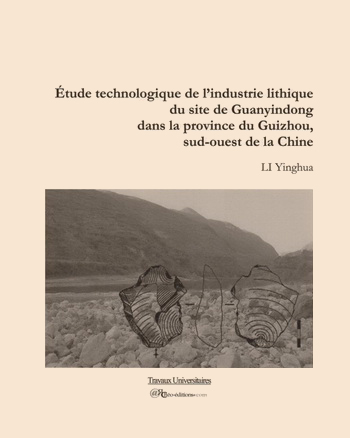 |
Etude technologique de l'industrie lithique du site de Guanyindong dans la province de Guizhou, sud-ouest de la ChineBy Yinghua Li2014 | @rchéo-éditions (external site) Copy Available: No Language: French Pages: 374 ISBN: 978-2-36461-007-1 Le site de Guanyindong, découvert en 1964, est une grotte karstique de la province du Guizhou, dans le sud-ouest de la Chine. L’industrie lithique, mise au jour au cours des trois campagnes de fouilles entreprises entre 1965 et 1973, est attribuée au pléistocène moyen final. L’étude présentée ici relève de l’analyse technologique élaborée par les chercheurs français, héritiers des travaux de Leroi-Gourhan. Cette approche, confère à ce travail toute son originalité, alors que les données de la préhistoire chinoise sont encore mal connues dans ce domaine. |
 |
Handbook of Alabama Archaeology : Part I Point TypesBy James W. Cambron, David C. Hulse2012 | The Archaeological Research Association of Alabama Inc. & Project Gutenberg (external site) Copy Available: Yes Language: English |
 |
Clovis TechnologyBy Bruce A. Bradley, Michael B. Collins, Andrew Hemmings, Marilyn Shoberg, Jon C. Lohse2010 | International Monographs in Prehistory Copy Available: No Language: English Pages: 220 ISBN: 978-1879621411 This book presents a detailed study of the lithic technology and the bone, antler, and ivory tool technology of the Clovis Paleoindian culture. It is abundantly illustrated with drawings and photographs of tools and the by-products of their manufacture, typical for this distinctive, very early period of human occupation of the United States. |
 |
Flint and Stone in the Neolithic PeriodEdited By Alan Saville2011 | Oxbow Books (external site) Copy Available: No Language: English Pages: 328 ISBN: 9781842174203 Lithic artefacts were an intrinsic part of Neolithic life both in terms of everyday practical use and in ritual/symbolic mode. Archaeologists and prehistorians studying the Neolithic period recognise this, and accordingly, strive to maximise relevant data recovery and subsequently exploit the available data to the full. Fulfilling these ambitions requires specialist input, which not only comes from lithic analysts themselves, but also draws on a wide range of expertise from across archaeology and other disciplines and practices. The papers in this volume demonstrate some of the diverse approaches and applications, both direct and theoretical, which are contributing towards our ultimate goal of allowing increased understanding of stone tools to reveal more about Neolithic life. |
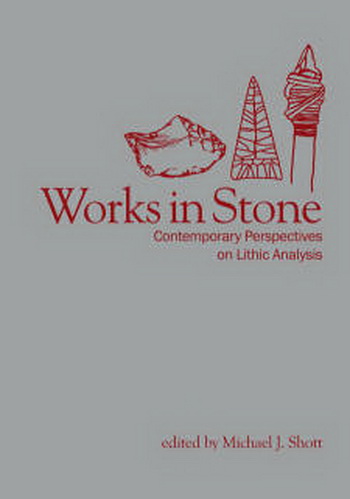 |
Works in Stone: Contemporary Perspectives on Lithic AnalysisEdited By Michael J. Shott2014 | University of Utah Press (external site) Copy Available: No Language: English Pages: 240 ISBN: 978-1-60781-382-8 Whether done by Stone Age hunters or artisans in ancient civilizations, the transformation of resistant stone into useful implements required skills with a high level of sophistication. Because stone tools are durable, today we have a lithic record to explain past behavior and the evolution of culture over long spans. Interpretive and analytical approaches to the study of stone tools, however, are often treated as independent, disconnected specialties. Works in Stone provides a broad look at the field of lithic analysis by bringing together a cross section of recent research. Scholars present a diverse range of concepts and methods with case studies that extend to every continent and contexts ranging from the Paleolithic to late prehistory. Showcasing the latest research of lithic analysts, Works in Stone provides a cohesive overview of recent methods and conclusions. |
 |
Prehension and hafting traces on flint tools. A methodologyBy Veerle Rots2010 | Leuven University Press (external site) Copy Available: No Language: English Pages: 298 ISBN: 9789058678010 The capacity to mount stone tools in or on a handle is considered an important innovation in past human behaviour. The insight to assemble two different materials (organic and inorganic) into a better functioning entity indicates the presence of the required mental capacity and technological expertise. Although the identification of stone tool use based on microscopic analysis was introduced in the 1960s, distinguishing between hand-held and hafted tool use has remained a more difficult issue. This volume introduces a methodology, based on a systematic, in-depth study of prehension and hafting traces on experimental stone artefacts, which allows their recognition in archaeological assemblages. The author proposes a number of distinctive macro- and microscopic wear traits for identifying hand-held and hafted stone tools and for identifying the exact hafting arrangement. Tested hafting arrangements vary according to the articulation between stone tool and handle, and to the raw materials and fixation agents used. Tool uses include various motions and worked materials. This largely experimental investigation concludes in a blind testing of the reliability of the method itself, showing that a wider application of the designed method has the potential to contribute significantly to our understanding of technological changes and evolutions and past human behaviour. |
 |
Ground Stone Analysis. A Technological ApproachBy Jenny L. Adams2014 | University of Utah Press (external site) Copy Available: No Language: English Edition: 2 Pages: 336 ISBN: 978-1-60781-273-9 A Copublication with Archaeology Southwest Archaeology Archaeologists define stone artifacts that are altered by or used to alter other items through abrasion, pecking, or polishing as “ground stone.” This includes mortars and pestles, abraders, polishers stones, and hammerstones, and artifacts shaped by abrasion or pecking, such as axes, pipes, figurines, ornaments, and architectural pieces. |
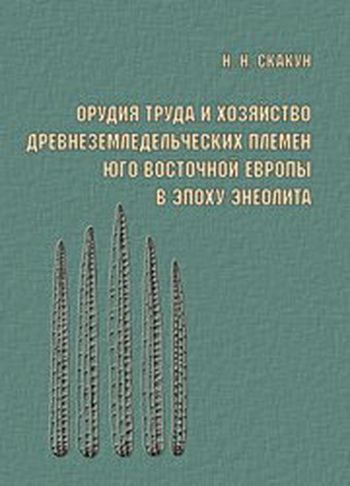 |
Орудия труда и хозяйство древнеземледельческих племен Юго-Восточной Европы в эпоху энеолита : по материалам культуры ВарнаBy Наталия Николаевна Скакун, Natalia Nikolaevna Skakun2006 | Нестор-История (external site) Copy Available: Yes Language: Russian Pages: 224 ISBN: 9785981871436 Книга Н. Н. Скакун «Орудия труда и хозяйство древнеземледельческих племен Юго-Восточной Европы в эпоху энеолита (по материалам культуры Варна)» посвящена изучению хозяйственных основ культуры Варна, одной из высокоразвитых археологических культур Юго-Восточной Европы, существовавшей во второй половине V тыс. до н. э. на территории современной Болгарии. Исследования включают комплексный анализ производственного инвентаря из неметаллического сырья (камня, рога, кости, глины), проведенный с помощью технико-типологического и экспериментально-трасологических методов. Такой подход позволил охарактеризовать особенности орудийных комплексов, их генезис, сделать сравнение с материалами синхронных культур, выяснить назначение инструментов, среди которых обнаружены орудия, неизвестные ранее. Полученные данные свидетельствуют о высоком уровне развития техники и о сложной структуре хозяйства древних земледельцев, отличительной особенностью которого являлось освоение пашенного земледелия и углубленная специализация производств, способствовавшая зарождению ранних форм ремесла. Данное исследование показывает значение орудий труда как исторического источника и представляет интерес для специалистов, занимающихся изучением экономических и культурных связей в древности, палеоэкономическими реконструкциями, вопросами возникновения и развития древнего земледелия на юго-востоке Европы и в сопредельных регионах. |
 |
L'outillage lithique en contextes ethnoarchéologiques / Lithic Toolkits in Ethnoarchaeological ContextsEdited By Xavier Terradas2005 | BAR Publishing (external site) Copy Available: No Language: English Pages: 64 ISBN: 978-1841718125 Acts of the XIVth UISPP Congress, University of Liège, Belgium, 2-8 September 2001, Colloque / Symposium 1.4 edited by Xavier Terradas. inc. VAT. i+64 pages; illustrated throughout with figures, tables and plates. BAR S1370 2005 British Archaeological Reports British Series (Book 1370) Arguing that flint tools alone reveal little about prehistoric societies, these eight papers use ethnological data to reconstruct the cultural, economic and social context of these tools. Taken from Symposium 1.4 at the XIVth UISPP Congress held at Liege in 2001, the papers consider evidence largely from sites in South America, Australia and Africa, looking at lithic material as well as associated evidence, such as worked bone, leather and grinding stones. This material is used to assess prehistoric hunting strategies, knapping procedures, the reasons for the use-wear of lithics and the opportunistic working of tools. Six papers in English, the rest are French; English abstracts. |
 |
Clovis Caches: Recent Discoveries and New ResearchEdited By Bruce B. Huckell, J. David Kilby2014 | University of New Mexico Press (external site) Copy Available: Yes Language: English Pages: 264 ISBN: 978-0826354822 The Paleoindian Clovis culture is known for distinctive stone and bone tools often associated with mammoth and bison remains, dating back some 13,500 years. While the term Clovis is known to every archaeology student, few books have detailed the specifics of Clovis archaeology. This collection of essays investigates caches of Clovis tools, many of which have only recently come to light. These caches are time capsules that allow archaeologists to examine Clovis tools at earlier stages of manufacture than the broken and discarded artifacts typically recovered from other sites. The studies comprising this volume treat methodological and theoretical issues including the recognition of Clovis caches, Clovis lithic technology, mobility, and land use. |
 |
Paleoindian Lifeways of the Cody ComplexEdited By Edward J. Knell, Mark P. Muñiz2013 | The University of Utah Press (external site) Copy Available: Yes Language: English Pages: 368 ISBN: 978-1-60781-229-6 Paleoindian Lifeways of the Cody Complex represents the first synthesis in the more than fifty year history of one of the most important Paleoindian cultural traditions in North America. Research on the Cody complex (~10,000–8,000 radiocarbon yrs B.P.) began in the 1940s; however, until now publications have focused almost exclusively on specific sites, issues of projectile point technology and typology, and bison hunting. This volume provides fresh perspectives and cutting-edge research that significantly increases our understanding of the Cody complex by focusing more squarely on the human behaviors that created the archaeological record, rather than on more strictly technical aspects of the artifacts and faunal remains. |
 |
Stone Artifacts of Texas IndiansBy Ellen Sue Turner, Thomas R. Hester, Richard L. McReynolds2011 | Taylor Trade Publishing (external site) Copy Available: No Language: English Edition: 3 Pages: 400 ISBN: 978-1589794641 Useful for academic and recreational archaeologists alike, this book identifies and describes over 200 projectile points and stone tools used by prehistoric Native American Indians in Texas. This third edition boasts twice as many illustrations—all drawn from actual specimens—and still includes charts, geographic distribution maps and reliable age-dating information. The authors also demonstrate how factors such as environment, locale and type of artifact combine to produce a portrait of these ancient cultures. |
 |
Elite Craft Producers, Artists, and Warriors at Aguateca: Lithic Analysis (Monographs of the Aguateca Archaeological Project Pirst Phase)By Kazuo Aoyama2009 | University of Utah Press (external site) Copy Available: Yes Language: English Edition: 1 Pages: 224 ISBN: 978-0874809596 This archaeological report centers on findings at Aguateca, a unique site in the Petexbatun region of the southern Mayan lowlands that was unexpectedly attacked in AD 810. The subsequent rapid abandonment and burning of many of the elite and non-elite residences at the site provide archaeologists with an encapsulated record of domestic and political activities on the last day of occupation. The in situ artifact assemblages from use and storage structures enable the study of specific activities and allow them to be addressed in depth owing to precise spatial patterning of the assemblages, which differ significantly from those of gradually abandoned sites. |
 |
Toward a Behavioral Ecology of Lithic Technology: Cases from Paleoindian ArchaeologyBy Todd A. Surovell2009 | University of Arizona Press (external site) Copy Available: No Language: English Pages: 296 ISBN: 978-0-8165-0738-2 Modern humans and their hominid ancestors relied on chipped-stone technology for well over two million years and colonized more than 99 percent of the Earth's habitable landmass in doing so. Yet there currently exist only a handful of informal models derived from ethnographic observation, experiments, engineering, and "common sense" to explain variability in archaeological lithic assemblages. |
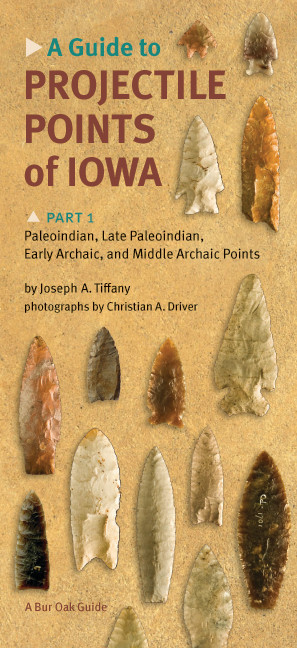 |
A Guide to Projectile Points of Iowa, Part 1: Paleoindian, Late Paleoindian, Early Archaic, and Middle Archaic PointsBy Joseph A. Tiffany2009 | University of Iowa Press (external site) Copy Available: No Language: English ISBN: 978-1-58729-826-4 |
 |
A Guide to Projectile Points of Iowa, Part 2: Middle Archaic, Late Archaic, Woodland, and Late Prehistoric PointsBy Joseph A. Tiffany2009 | University of Iowa Press (external site) Copy Available: No Language: English ISBN: 978-1-58729-828-8 |
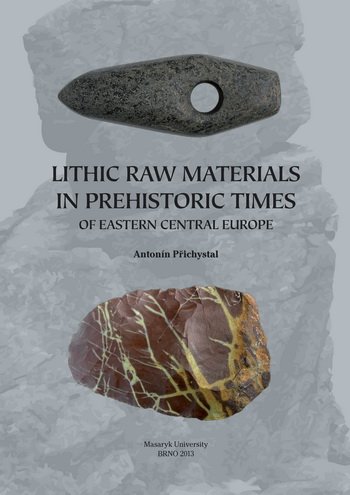 |
Lithic raw materials in prehistoric times of eastern Central EuropeBy Antonín Přichystal2013 | Masaryk University (external site) Copy Available: No Language: English Pages: 351 ISBN: 978-80-210-6405-8 The book comprises results of the author’s cooperation with archaeologists during the last 35 years and systematically describes lithic raw materials used in prehistoric times of Eastern Central Europe. It covers the area of Czech Republic, Slovakia, Hungary, Poland, eastern part of Germany (Saxony, Thuringia and Bavaria) and northern Austria. Introductory chapters present brief survey of geomorphological and geological units with potential rock sources. Than, various methods of natural science suitable for determination of lithic artefacts are characterized. The principal chapter describes in detail individual rocks and minerals for chipped artefacts. Raw materials for polished axes and battleaxes, wristguards, whetstones, millstones and whorls are introduced in a similar way. The attention is also focused on sources of rock-salt, the usage of fossils in prehistory and finds of pseudoartefacts or fakes. Within the text there are 147 black-and-white pictures or maps and the final annex contains 384 coloured photos of raw materials seen by naked eye, under a stereomicroscope, in a thin section or as interesting artefacts. |
 |
Experimentación en arqueología: Estudio y difusión del pasadoEdited By Antoni Palomo, Raquel Piqué, Xavier Terradas2014 | Museu d'Arqueologia de Catalunya (external site) Copy Available: Yes Language: Spanish; Castilian Pages: 524 ISBN: 978-84-393-9024-4 Els volums recullen les contribucions presentades en el III Congrés internacional d’Arqueologia Experimental, celebrat a Banyoles (Girona) els dies 17, 18 i 19 d’octubre de 2011. These volumes correspond to the proceedigns of the Third International Conference on Experimental Archaeology, held in Banyoles (Girona, Spain) in 2011. |
 |
Variabilité et signification des productions lithiques au Paléolithique moyen ancien: l'exemple de trois gisements de plein-air du Bergeracois (Dordogne, France)By Michel Brenet2013 | BAR Publishing (external site) Copy Available: No Language: French Pages: 352 ISBN: 9781407311685 This work addresses the question of inter- and intra-site variability and its behavioral significance through a techno-economic analysis of lithic industries and an experimental procedure. For nine lithic assemblages from three sites in South-West of France, Cantalouette 1, Combre Brune 2 and Combe Brune 3, each of the production methods was analyzed based on a quantitative evaluation of all the operational phases present from the procurement of lithic raw materials to the use of the products. The role of experimentation in this procedure is to create specific reference bases that can be compared with the lithic assemblages in order to obtain a better estimation of their techno-economic representation. |
 |
Elephantine XXXV: The Lithic Industries on Elephantine Island during the 3rd Millennium BCBy Thomas Hikade2014 | Harrassowitz Verlag (external site) Copy Available: No Language: English Pages: 210 ISBN: 9783447101318 With nearly 5000 years of continuous occupation and stratigraphy, the island of Elephantine is one of the most important archaeological sites in Egypt. It was also the traditional southern frontier of ancient Egypt. The German Archeological Institute has been excavating on Elephantine Island since 1969 in close cooperation with the Swiss Institute for Architectural and Archaeologial Research, resulting in dozens of publications documenting the progress of the archaeological work. In his volume on the lithic industries, Thomas Hikade has analysed more than 10,000 lithic artifacts of the 3rd millennium BC (Early Dynastic to First Intermediate Period) excavated over 20 campaigns (1984-2004). He discusses the primary and secondary industries of the site, presenting the stone tool assemblage from various parts of the settlement in detailed tables, charts, and line drawings In some cases the analysis is so detailed as to cover the archaeological context of the single room of a house. The author also discusses the various raw materials used in the making of Egyptian stone tools and places the lithic industries of the 3rd millennium BCfrom Elephantine Island into the broader context of the Egyptian economic system. The study closes with a catalogue of 465 selected objects of the whole collection accompanied by drawings. |
 |
Lithic raw material exploitation and circulation in Prehistory: A comparative perspective in diverse palaeoenvironmentsBy Masayoshi Yamada, Akira Ono2014 | University of Liege (external site) Copy Available: No Language: English Pages: 230 ISBN: 978-2-930495-24-8 |
 |
한국 구석기 시대 석기군 연구By 상태 김, Sang Tae Kim2012 | 서경 문화사 Copy Available: No Language: Korean Pages: 192 ISBN: 9788960620841 |
 |
Tecnología lítica de la Puna meridional Argentina: estrategias tecnológicas conservadas en la producción de artefactos agrícolas en contextos agropastoriles tempranosBy Susana Pérez2012 | Editorial Dunken (external site) Copy Available: No Language: Spanish; Castilian Pages: 184 ISBN: 978-9870261032 Este libro aborda, desde la perspectiva de la organización de la tecnología lítica, la implementación de una estrategia tecnológica conservada y cómo la misma se ve reflejada en algunas variables del diseño de artefactos agrícolas (palas y/o azadas), de contextos agropastoriles tempranos (Formativos) de Antofagasta de la Sierra, Puna Meridional Argentina. Ofrece un estudio desde varias vías de investigación: el análisis técnico-morfológico y morfológico-funcional, un programa experimental tendiente a la replicación, enmangue y uso del instrumental, y el análisis de los rastros producidos por el uso en ambas colecciones, la arqueológica y la experimental de referencia. |
 |
縄文・弥生時代石器研究の技術論的転回By 上峯 篤史, Atsushi Uemine2012 | 雄山閣 (external site) Copy Available: No Language: Japanese Pages: 310 ISBN: 9784639022176 近畿地方における縄文・弥生時代のサヌカイト製石材を対象に、徹底した遺物観察と定量分析に基づいた剥片剥離技術と打撃法の研究から、縄文~弥生移行期の石材消費戦略、集落間関係の実態と変容を明らかにする。 |
 |
最終氷期における細石刃狩猟民とその適応戦略: Adaptive strategies of the microblade hunters in the last glacialBy 堤 隆, Takashi Tsutsumi2011 | 雄山閣 (external site) Copy Available: No Language: Japanese Pages: 357 ISBN: 9784639021889 後期旧石器時代末、細石刃と呼ばれるカミソリの刃ほどの小さな石器が日本列島に広く展開した。 |
 |
The Technology of Maya Civilization: Political Economy and Beyond in Lithic StudiesBy Zachary X. Hruby, Geoffrey E. Braswell, Oswaldo Chinchilla Mazariegos2011 | Routledge (external site) Copy Available: No Language: English Pages: 224 ISBN: 9781845535087 The ancient Maya shaped their world with stone tools. Lithic artifacts helped create the cityscape and were central to warfare and hunting, craft activities, cooking, and ritual performance. The Technology of Maya Civilization examines Maya lithic artefacts made of chert, obsidian, silicified limestone, and jade to explore the relationship between ancient civilizations and natural resources. The volume presents case studies of archaeological sites in Guatemala, Mexico, Belize, and Honduras. The analysis draws on innovative anthropological theory to argue that stone artefacts were not merely cultural products but tools that reproduced, modified, and created the fabric of society. |
 |
Crowfield (AfHj-31): A Unique Paleoindian Fluted Point Site from Southwestern OntarioBy D. Brian Deller, Christopher J. Ellis2011 | Museum of Anthropological Archaeology (University of Michigan) (external site) Copy Available: No Language: English Pages: 224 ISBN: 978-0-915703-76-0 |
 |
Crowfield (AfHj-31): A Unique Paleoindian Fluted Point Site from Southwestern OntarioBy D. Brian Deller, Christopher J. Ellis2011 | Museum of Anthropological Archaeology (University of Michigan) (external site) Copy Available: No Language: English Pages: 224 ISBN: 978-0-915703-76-0 |
 |
後期旧石器時代前半期石器群の研究 : 南関東武蔵野台地からの展望By Takuya Yamaoka, 拓也 山岡2012 | 六一書房 (external site) Copy Available: No Language: Japanese Pages: 186 ISBN: 9784864450201 |
 |
Bipoints Before ClovisBy Wm. Jack Hranicky2012 | Universal Publishers (external site) Copy Available: Yes Language: English Pages: 394 ISBN: 9781612331362 This archaeological publication covers the development, definition, classification, and world-wide deployment of the lithic bipoint and includes numerous photographs, drawings, and maps. Lithic bipoint technology originated 75,000 years ago, and it continued to the discovery of metal for tools. It was brought into the U.S. on both coasts; the Pacific Coast introduction was around 17,000 years ago and the Atlantic Coast was 23,000 years ago. This book presents and discusses bipoints from nearly every U.S. state. Bipoint function, usage, and resharpening are also presented. The book is indexed and has extensive references. |
To request a book for review, please email journaloflithicstudies@gmail.com.





